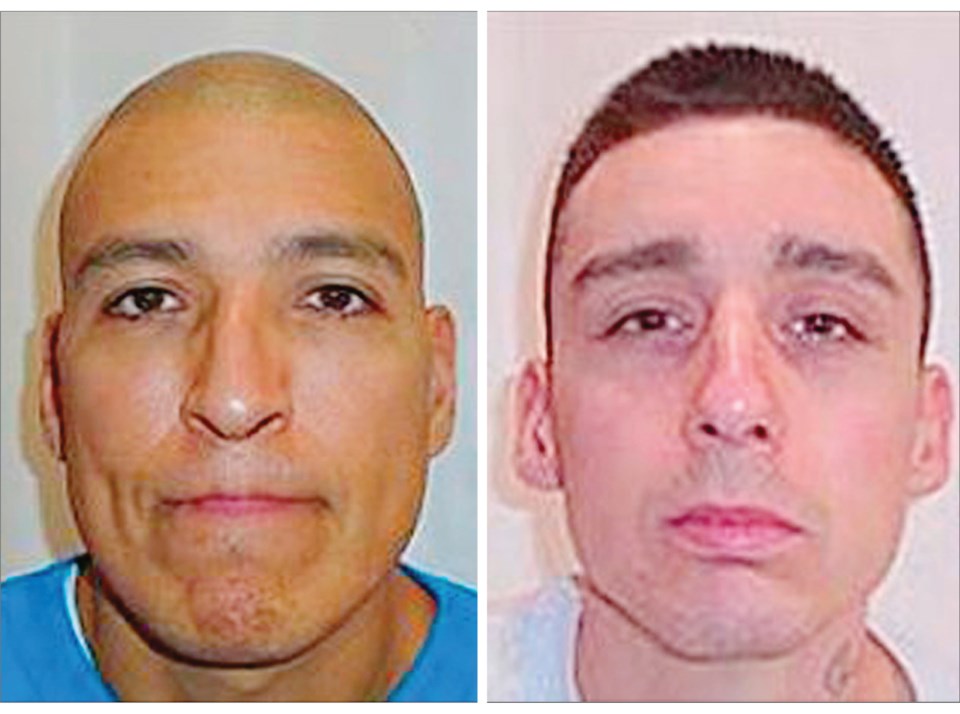Warning: This story contains graphic details of a violent attack.
Martin Payne was attacked from behind with a hatchet and from the front with a bowie knife as he fought for his life in his Metchosin home three years ago, a B.C. Supreme Court jury heard Monday.
It took two people to murder Payne, prosecutor Chandra Fisher said in closing submissions at James Lee Busch’s trial for the first-degree murder of the 60-year-old provincial government mail carrier.
Zachary Armitage, who is also charged with the first-degree murder of Payne on July 8, 2019, is no longer in the courtroom. The jury has been told he is “being dealt with in a separate way.”
Fisher told the jury that four chop wounds on the top and back of Payne’s head came from the back and moved forward.
“Mr. Payne was not facing the man with the hatchet. The attack must have come from behind,” she said.
The chop wounds were so deep, they fractured his skull and were fatal, said the prosecutor.
Small blunt puncture wounds on his chest and a defensive wound on his hand indicate Payne was also trying to fend off a knife attack from the front, said Fisher.
A catastrophic throat wound severed Payne’s carotid artery, jugular vein and trachea and was so deep it touched the spine, she said. “Mr. Payne was inhaling blood as he died from those wounds.”
A smaller knife was also used to inflict a small deep wound on Payne’s shoulder and puncture wounds on his chest.
“One person could not use all three of these weapons,” said Fisher. “It was both Mr. Armitage and Mr. Busch working together. Why would any one person need to inflict both sets of injuries? You don’t need to kill the man twice.”
The Crown’s theory is that Armitage and Busch were together from the time they walked away from William Head penitentiary at low tide on July 7, 2019, until their arrest two days later in downtown Victoria.
Forensic evidence in Payne’s house proves Busch and Armitage were there, planning their attack, waiting for more than eight hours for Payne to come home, said Fisher.
“We know they are on the run. They’ve escaped prison and they need a place to hide out. … Mr. Payne’s house is in a rural neighbourhood on a dead-end street. It must have been the perfect place to wait.”
The jury has heard that Payne left for work at 6:15 a.m. on July 8. By 6:57 a.m., someone was using his computer to search the Internet for local news, along with information on Corrections Canada, Zachary Armitage and private water taxi.
At 8:15 a.m., Armitage called a water taxi service to find out if they went to the mainland. Armitage also called two friends asking for help, some money and a ride. Neither wanted to become involved.
Armitage left his fingerprints on a glass in the kitchen and on a duct-tape dispenser in the master bedroom. His palm print was also on a note saying “What is your pins for cards” that was found by Payne’s computer. Busch’s fingerprints were not found in the home.
DNA from both men was found in the home.
Armitage’s DNA was found on a white shirt, a white leather glove and a sock found in a garbage bag. Payne’s blood was on those items. Armitage’s DNA was found on chewing gum in the bathroom.
Busch’s DNA was found on two pairs of underwear and on the inside of a New Balance shoe. Payne’s blood was found on the left thigh of one pair of underwear.
Fingerprints from both Busch and Armitage were found on a newspaper in Payne’s truck, which they stole and drove to Oak Bay.
The two men had more than eight hours to plan what they were going to do, said Fisher. But they didn’t leave. They waited because they saw Payne’s financial documents and they needed the PIN or secret code for his bank card.
They cut the heads off two axes, said Fisher, planning to beat Payne with the axe handles to force him to give up his PIN. They found duct tape to tie him up and walkie-talkies to co-ordinate the attack. They also had the hatchet and the bowie knife.
When Payne arrived home just before 3:30 p.m., someone was waiting for him in the kitchen and struck the first blow.
Payne, who was five-foot-10-inches tall and 200 pounds, was bigger than either Busch or Armitage. He would have been fighting with all his strength, knowing his life was at stake, said Fisher.
“Do you think one person could have done to Mr. Payne what the autopsy photos showed us and come out unscathed?” she asked.
Fisher believes one man held Payne down while the other tried to wrap duct tape around him.
After the murder, the two men tried to clean up the evidence, attempting to wipe the blood off themselves and their clothes. They placed towels, blankets, washcloths, shoes, and gloves into garbage bags in the bedroom.
Busch and Armitage planned from the beginning either to kill Payne or to unlawfully confine him and ended up killing him in the course of that confinement, argued Fisher.
“They planned and they waited and they waited and they planned. They had two weapons of deadly force. When you arm yourself with those two weapons, you’re planning to kill someone.”
The two men never intended to let Payne live, she said.
“They needed him to be silent or they would be going right back to jail.”
Busch’s defence lawyer will continue his submissions today.



